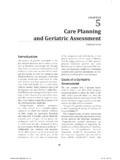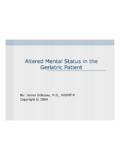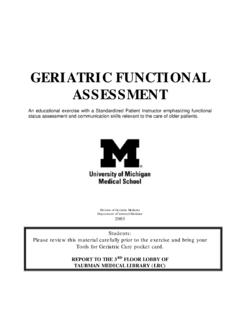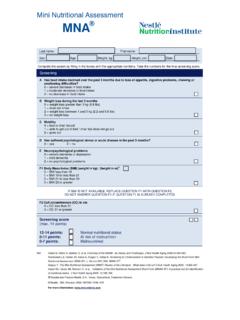Transcription of PRACTICE GUIDELINE Comprehensive Geriatric …
1 PRACTICE GUIDELINE . Comprehensive Geriatric assessment (CGA). in oncological patients Version: 20 July 2011. This GUIDELINE was established under the auspices of the educational committee of SIOG. The guidelines are available at the SIOG website, and are meant to become an uptodate' system where health care workers can add new evidence or information if required. All information or questions can be addressed to SIOG at the email address Concept: Cindy Kenis and Hans Wildiers Coworkers: Ulrich Wedding, Martine Extermann, Koen Milisen, Johan Flamaing Content 1 Geriatric oncology .. 4. Comprehensive Geriatric 4. Methodology .. 4. Content of a CGA .. 5. 2 Evaluation instruments: screening tools .. 6. 6. G8 .. 7. Flemish version of the Triage Risk Screening Tool .. 10. Groninger Frailty Indicator .. 14. Vulnerable Elders Survey - 17.
2 Senior Adult Oncology Program 2 .. 22. Abbreviated Comprehensive Geriatric assessment .. 27. 3 Evaluation instruments: 32. 32. Activities of Daily Living .. 33. Barthel Index .. 38. Instrumental activities of Daily Living .. 43. Falls .. 52. Mini Mental State Examination .. 54. Clock Drawing Test .. 63. Geriatric Depression 69. Mini Nutritional assessment .. 74. Mini Nutritional assessment (MNA).. 74. Mini Nutritional assessment Short Form (MNA-SF) .. 77. Charlson Comorbidity Index (CCI) .. 84. Cumulative Illness Rating Scale for Geriatrics .. 89. 4 Practical issues .. 92. Which patients to evaluate? .. 92. Methodology .. 93. Organizational 93. Page 2. Way of reporting .. 94. Interventions .. 94. Use in clinical PRACTICE .. 95. 5 Case 97. 6 Prediction of toxicity with Geriatric 100. 7 Usefull information .. 101. 8 102.
3 Page 3. 1 Geriatric oncology A Comprehensive Geriatric assessment (CGA) is the most appropriate method to obtain a view on the general health status of an older individuals (including social situation, functionality, falls, cognitive and mood changes, nutritional status, ). It completes history taking and physical examination. It was developed in Geriatric medicine as diagnostic tool, as tool to plan care and interventions and as tool to assess quality of care. A CGA allows to detect multiple problems that are often unknown for the treating oncologist. It allows also to organize specific interventions where needed. Comprehensive Geriatric assessment The definition of CGA according to the Consensus Conference, supported by the National Institute of Aging in 1989, states the following: CGA is a multidimensional, interdisciplinary patient evaluation that leads to the identification of patient's problems.
4 In other words, CGA is characterized by a multidimensional evaluation of the general health status but also functional, cognitive, social and psychological parameters of older persons. Methodology A screening instrument can be used initially for risk detection. If the screening indicates the presence of a Geriatric risk profile, a CGA can be performed. This two-step' approach is recommended in the guidelines of the National Comprehensive Cancer Network (NCCN) (see figure 1). Page 4. Figure 1: 2-step approach in Geriatric assessment Screening test normal abnormal stop Comprehensive Geriatric assessment (CGA). Content of a CGA. The CGA consists of different evaluation instruments and is generally performed by interview or by performance tests. During this contact (+/- 30 to 45 minutes), several core domains are evaluated: - Demographic data o Marital status o Living situation o Professional home care o Level of education - Functionality including falls - Cognitive status - Depression - Nutritional status Other relevant domains than can be evaluated are listed below: - Pain - Fatigue - Quality of life.
5 Comorbidity and polypharmacy are also considered to be part of a CGA, but are generally available in the medical file of the patient. However for quantification of comorbidity, validated scales can be used (see further). Page 5. 2 Evaluation instruments: screening tools Overview Table 1: DOMAIN INSTRUMENT. Screening tool - G8. - Flemish version of the Triage Risk Screening Tool (TRST). - Groninger Frailty Indicator (GFI). - Vulnerable Elders Survey 13 (VES-13). - Senior Adult Oncology Program 2 (SAOP2). - abbreviated Comprehensive Geriatric assessment (aCGA). Page 6. G8. Instrument G8. Abbreviation G8. Author Soubeyran et al. Subject Screening Goal Detection of a Geriatric risk profile Population Older Cancer Patients Taken by Health care professional Number of items 8. Participation of the patient Yes Reference Soubeyran P, Bellera CA, Gregoire F, et al.
6 Validation of a screening test for elderly patients in oncology. J Clin Oncol 2008; 26(suppl 20): abstr 20568. Soubeyran P, Bellera C, Goyard J ,et al. Validation of the G8 screening tool in Geriatric oncology: the ONCODAGE project. J Clin Oncol 2011; abstr 9001. Instrument can be found at: Permission required No Translations available - English - French - Dutch - German - . Goal The G8 is used for the identification of older persons with cancer with a Geriatric risk profile where a full CGA is required. Target population The G8 is meant for older persons. Description The G8 is a screening instrument based on the MNA, with addition of an age related component. Method - Interview Scoring - Total score = 17. Page 7. - Range total score = 0-17. - Cut-off: 14. Interpretation - 0 - 14 = presence of a Geriatric risk profile - > 14 = absence of a Geriatric risk profile Instructions 1.
7 Indicate the correct answer for each question. 2. Make a sum of all scores and calculate the total score. Remarks 1. Validation The G8 has been prospectively validated in the Oncodage study. The cutoff of 14 or lower was confirmed as the optimal threshold, with a sensitivity of 76,6% and a specificity of 64,4%. Compared to the VES13, the G8 was more sensitive ( versus ) although its specificity was inferior ( versus ). 2. User friendliness. It takes about 2 to 3 minutes to complete the screening. References 1. Soubeyran P, Bellera CA, Gregoire F, et al. Validation of a screening test for elderly patients in oncology. J. Clin Oncol 2008; 26(suppl 20): abstr 20568. 2. Soubeyran P, Bellera C, Goyard J ,et al. Validation of the G8 screening tool in Geriatric oncology: the ONCODAGE project. J Clin Oncol 2011; abstr 9001. Page 8.
8 Example G8. Items Possible answers Score Has food intake declined over the past 3 0 = severe reduction in food intake A months due to loss of appetite, digestive 1 = moderate reduction in food intake .. problems, chewing or swallowing difficulties? 2 = normal food intake Weight loss during the last 3 months? 0 = weight loss >3kg 1 = does not know .. B. 2 = weight loss between 1 and 3 kg 3 = no weight loss Mobility 0 = bed or chair bound 1 = able to get out of bed/chair but does .. C. not go out 2 = goes out Neuropsychological problems 0 = severe dementia or depression E 1 = mild dementia or depression .. 2 = no psychological problems 2. Body Mass Index (weight in kg/height in m ) 0 = BMI <19. 1 = 19 BMI < 21 .. F. 2 = 21 BMI < 23. 3 = BMI 23. Takes more than 3 medications per day 0 = yes H. 1 = no .. In comparison with other people of the same 0,0 = not as good age, how does the patient consider his/her 0,5 = does not know.
9 P. health status? 1,0 = as good 2,0 = better Age 0 = >85. 1 = 80-85 .. 2 = <80. Total score (0-17) .. Page 9. Flemish version of the Triage Risk Screening Tool Instrument Flemish version of the Triage Risk Screening Tool Abbreviation Flemish version of the TRST. Author Deschodt et al. Subject Screening Goal Detection of a Geriatric risk profile Population Older Patients / Older Cancer Patients Taken by Health care professional Number of items 5. Participation of the patient Yes Reference Deschodt, M., Wellens, N., Braes, T., De Vuyst, A., Boonen, S., Flamaing, J., Moons, P., Milisen, K. (2011). Prediction of Functional Decline in Older Hospitalized Patients: a Comparative Multicentre Study of Three Screening Tools. Aging Clinical and Experimental Research (In press). Instrument can be found at: /. Permission required No Translations available - Dutch - English Goal The Flemish version of the TRST is used for the identification of older persons with a Geriatric risk profile where a full CGA is required.
10 Target population The Flemish version of the TRST is meant for older persons. Description The Flemish version of the TRST is a translation and adaptation of the Triage Risk Screening Tool (Meldon et al., 2003) and includes the following 5 items: 1. Presence of cognitive decline 2. Living alone or no help from family / partner 3. Reduced mobility or fallen in the past 6 months 4. Hospitalized in the past 3 months 5. Polypharmacy ( 5 different medications). Method - Interview Scoring - Total score = 6. - Range total score = 0-6. Page 10. - Cut-off: o 1 (in oncology). o 2 (in geriatrics). Interpretation - Oncology o Score 0: absence of a Geriatric risk profile o Score 1: presence of a Geriatric risk profile - Geriatrics o Score 0 1: absence of a Geriatric risk profile o Score 2: presence of a Geriatric risk profile Instructions - Circle the right answer on the different questions.





